Nestled in the mountains of north-east Vietnam, the peaceful oasis of Ba Be National Park reveals breathtaking scenery. Literally “three lakes” in the Tay language, where it's called “Slam Pe”, this natural sanctuary conceals a priceless treasure: the rich cultural diversity of its ethnic minorities.
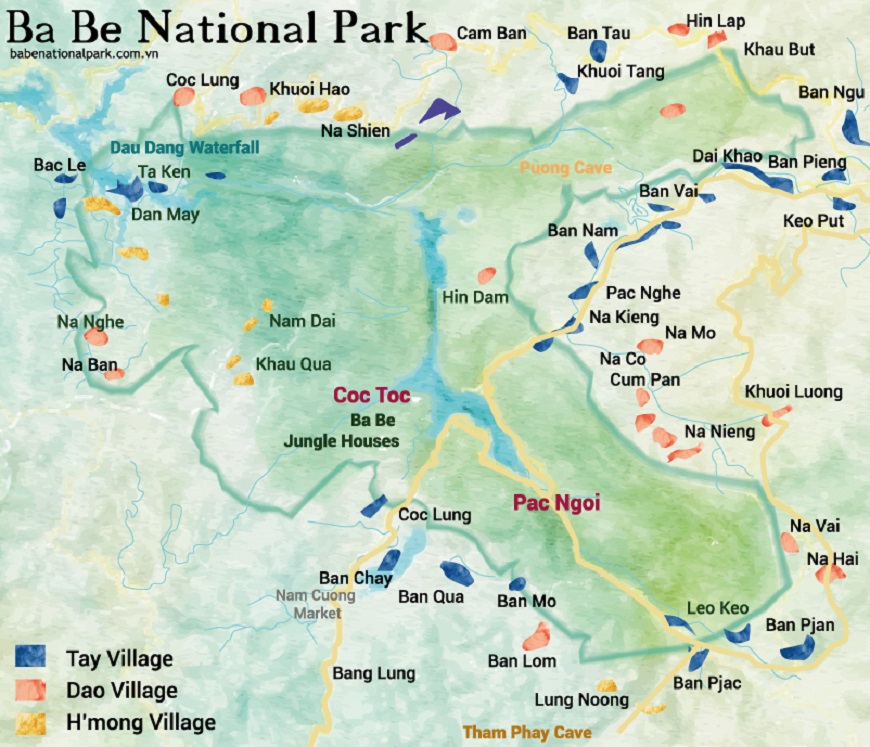
Map of Ba Be National showing the main ethnic villages - Source : Mr Linh's adventures
Introduction
Created on November 10, 1992 to preserve the region's wild splendors, the park's mission is also to protect the ancestral way of life of the communities that have lived here for centuries. These ethnic groups, divided into thirteen villages, some of which are home to a single group, include the Tays, Daos, H'mongs and Nungs. Each has its own language, traditional costumes and customs, forming a vibrant cultural mosaic within Ba Be National Park.
Meet the Tays, a people intimately linked to lakes and rivers

Tay People, Long Tong Festival, Ba Be - Source : Mr Linh's adventures
The first inhabitants to settle around Lake Ba Be over 2 millennia ago, the Tays are the region's majority ethnic group. Accustomed to living by the water's edge, they have developed expertise in fishing and rice-growing. Their traditional wooden and bamboo dwellings on stilts blend harmoniously with the surrounding green landscape.
Rooted in animist beliefs, this community worships the spirits of nature, celebrated in colorful festivals with ancestral dances and songs. A highlight of their calendar is the Tay New Year, in lunar February or March, when villages come alive to the rhythms of drums and gongs, while the inhabitants dress in their finest traditional finery.
Tay culture, imbued with family values and respect for ancestors, is expressed through many lively festivities, such as the Nguyen Dan Tet festival and the Sla festival. Their brightly geometrically embroidered clothing and emblematic instruments such as the t'ru and khen add a vibrant touch to their identity.
In the villages of Nam Dai, Pac Ngoi and Ban Cam, you can meet the Tays, famous builders of wooden houses on stilts. Living from agriculture and fishing, they skilfully craft their monoxyle dugout canoes. In addition to their woodworking skills, they also excel at weaving. Immerse yourself in the folk songs and dances that enliven these villages.
Did you know? The Tays believe that the spirit of the deceased inhabits a specific tree, to which they pay homage by decorating it with colorful fabrics.
The Daos: holders of the secrets of medicinal herbs
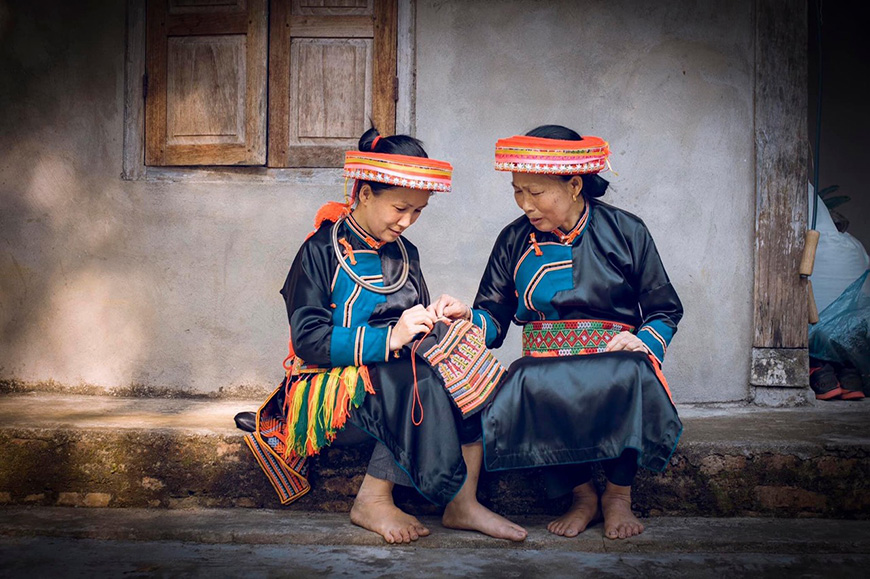
Dao ladies,Quang Khe commune (Ba Be) - Photo: Đăng Hải for Bac Kan official website
Recognizable by their brightly-colored clothing and elaborate headdresses, the Daos are renowned for their exceptional crafts, notably weaving and embroidery. Their hilltop villages offer breathtaking panoramic views of the surrounding valleys.
In addition to their artistic talent, this ethnic group is renowned for its extensive knowledge of traditional medicine. The Daos use the medicinal plants and herbs growing in the forests to treat various ailments and ease suffering.
Their rich and complex culture, imbued with animist and shamanic practices, is reflected in their colorful rituals and festivals. Music and dance play a key role among this people, whose emblematic instruments such as the “dan bau” violin and the “eng” drum resonate throughout the park's valleys.
The village of Na Nghe, tucked away at altitude, provides an opportunity to meet the welcoming Daos.
After a hike through unspoilt nature, you'll be rewarded with a breathtaking view of the valley. You can also discover the traditional relaxation method of the herbal bath: bask in huge cauldrons of hot water infused with aromatic scents, letting the medicinal plants unfold their soothing virtues. The lakeside village of Coc Toc, on the shores of Lake Ba Be, is also inhabited by this minority.
Did you know? The Daos believe that dragons, symbols of good luck, reside in sacred rivers and natural springs.
The Hmong, guardians of age-old traditions
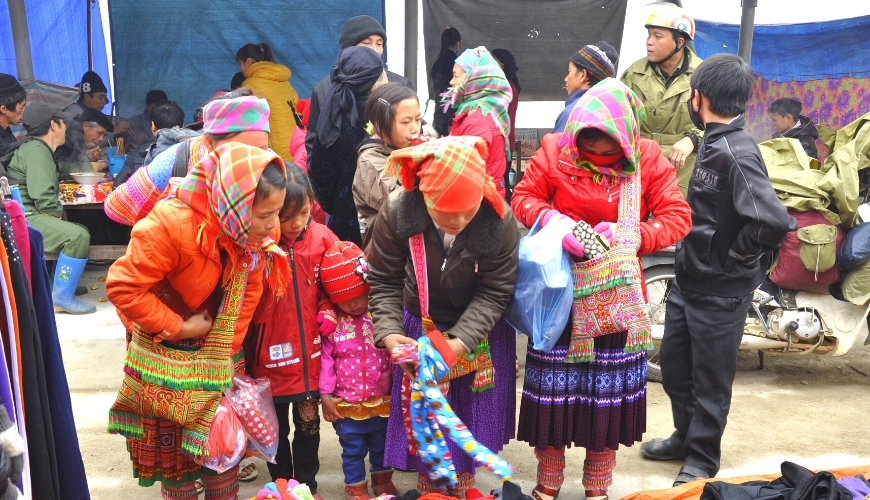
H'mong People,Ba Be market - Source : Mr Linh's adventures
A more recent arrival in the region, the Hmongs stand out for their singular customs and way of life. They generally live in mountain villages, cultivating rice terraces and raising livestock. This close-knit community is proud to perpetuate its ancestral traditions. Their language, a member of the Hmong-Mien family, has many dialects, depending on the sub-groups that comprise the White, Black and Green Hmongs, the latter mainly cultivating corn, the main ingredient of their daily cuisine.
Their rich culture is evident in their intricately embroidered clothing, silver jewelry and emblematic headdresses. The Hmong are also renowned for their haunting polyphonic songs and rhythmic dances, which enliven their many festivities and celebrations.
Their animist culture worships the spirits of nature and ancestors, with shamans playing a key role in spiritual life. In addition to their songs and dances, Hmong rituals are also marked by their exceptional handicrafts.
This people with their distinct language are also famous for their warm hospitality. Intriguing anecdote: at Hmong weddings, couples exchange silver bracelets, symbols of love and eternal fidelity, which they will wear for the rest of their lives.
In the village of Bo Lu, you can visit traditional Hmong homes, learn more about their way of life and culture, and even take part in agricultural work alongside the villagers. Don't miss the chance to taste the Khua Quang hamlet's corn alcohol, a local pride and joy with a unique taste.
The Nungs: Masters of blacksmithing and agriculture
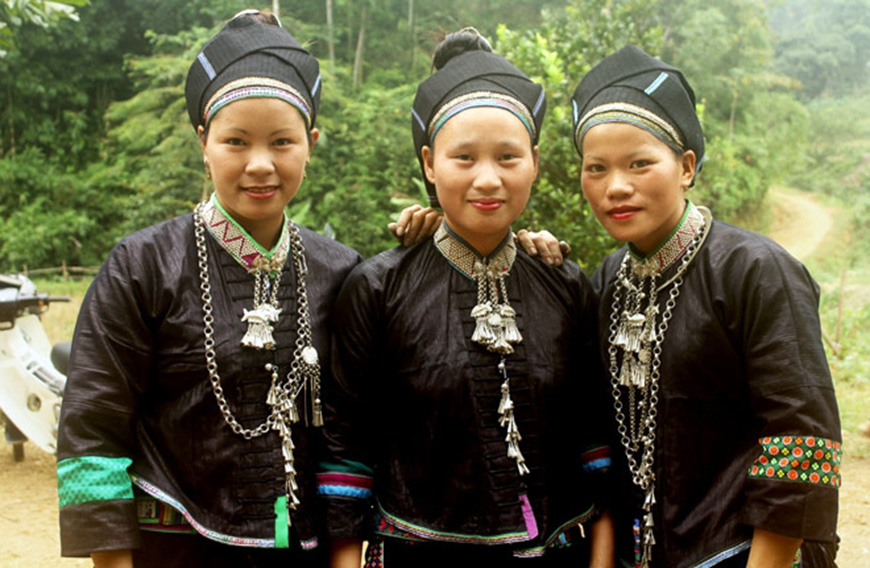
Traditional Attire of Nung Women - Source : Internet
Living in the valleys of Ba Be National Park, the Nungs are skilled craftsmen and farmers. They excel in ironworking, forging high-quality tools and weapons. Their ancestral agricultural techniques enable them to grow a wide variety of crops such as rice, corn and vegetables.
Nung culture is also marked by deep spiritual traditions. They worship their ancestors with regular ceremonies. Their music and dance, often accompanied by gongs and drums, reflect their deep connection with nature and the spiritual world.
Their unique language and delicately embroidered traditional costumes bear witness to a rich cultural heritage. Interesting anecdote: the Nungs attach great importance to the New Year festival, when they make offerings to ancestors and spirits to ensure a good harvest.
And let's not forget...
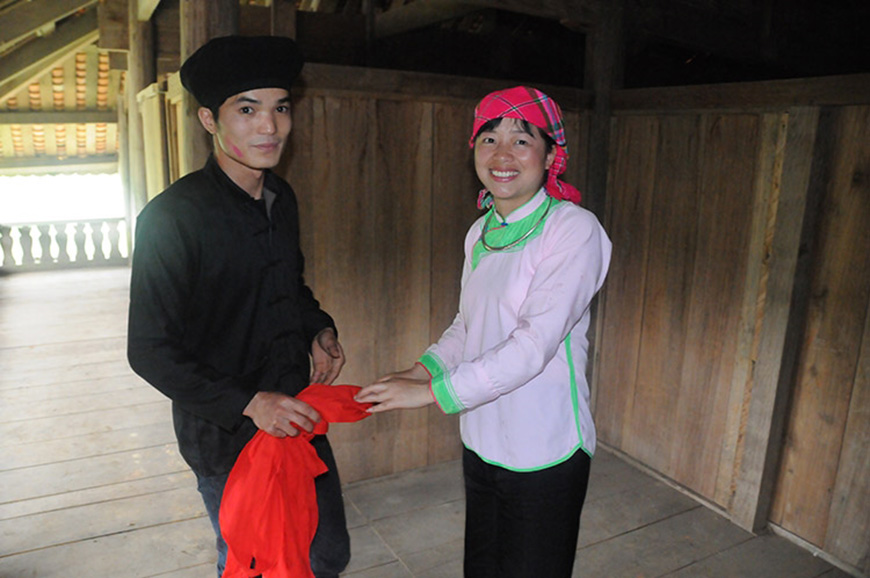
Giay People - Source : Internet
The Giay: Although less numerous than other groups, the Giay occupy the mountainous areas of the park. Their language belongs to the Austroasiatic family, and their traditional architecture is characterized by wooden dwellings with thatched roofs. They are renowned for their exceptional craftsmanship, particularly pottery and basketry.
San Diu: This ethnic minority lives mainly in the heart of the park's forests. Their culture is intimately linked to the forest environment, which they know intimately. Practicing hunting, gathering and slash-and-burn agriculture, the
San Diu perpetuate the shamanic rituals and animistic beliefs intrinsic to their identity.
Each of these communities has preserved its age-old traditions within Ba Be Park, making the region a veritable cultural crossroads. This expressed ethnic diversity is a real treasure to be discovered by all visitors curious about the riches of Vietnam.
In addition to these main groups, other ethnic minorities such as the
Sán Chay,
La Chi and
Pu Péo also live in the park. Although less well known and with smaller populations, they nonetheless contribute to the unique cultural diversity of this area.
Did you know? Bac Kan province is home to 34 ethnic minorities, the largest of which are the Tay, Nung, Dao, Mong, San Chay and Hoa.
Ba Be National Park: unforgettable immersion in authentic Vietnamese culture
Whether you're a trekking and adventure enthusiast or simply looking for a privileged contact with the local culture, Ba Be National Park promises an unforgettable stay. Meet the ethnic minorities, discover their age-old traditions and be charmed by the unspoilt wild beauty of this exceptional natural sanctuary.
Beyond the breathtaking scenery, exploring these magical places offers you the unique opportunity to meet fascinating ethnic communities, discover their stories and immerse yourself in their ancestral customs. Whether you're an avid traveler or a lover of Indochina, a visit to Ba Be Park is an enriching journey into the heart of Vietnamese culture.
Get ready to be carried away by the beauty of these minorities and create lasting memories.

Ba Be National Park - Source : Mr Linh's adventures
Tips for preparing your visit
- The park is accessible all year round, but the ideal periods are March to May and September to November.
- A variety of accommodation options are available, from bungalows to homestays.
- Hire a local guide for an in-depth exploration of the park and its ethnic villages.
- Respect the habits and customs of the people you meet.
By visiting Ba Be Park, you'll not only be helping to preserve this unique natural environment, but also safeguarding the precious cultures of the minorities who live there. Don't wait any longer to discover the cultural treasures of Ba Be National Park!
- The park is accessible all year round, but the ideal periods are March to May and September to November.
- A variety of accommodation options are available, from bungalows to homestays (we recommend Ba Be Jungle Houses).
- Hire a local guide for an in-depth exploration of the park and its ethnic villages.
- Respect the habits and customs of the people you meet.
By visiting Ba Be Park, you'll not only be helping to preserve this unique natural environment, but also safeguarding the precious cultures of the minorities who live there.
Don't wait any longer to discover the cultural treasures of Ba Be National Park!